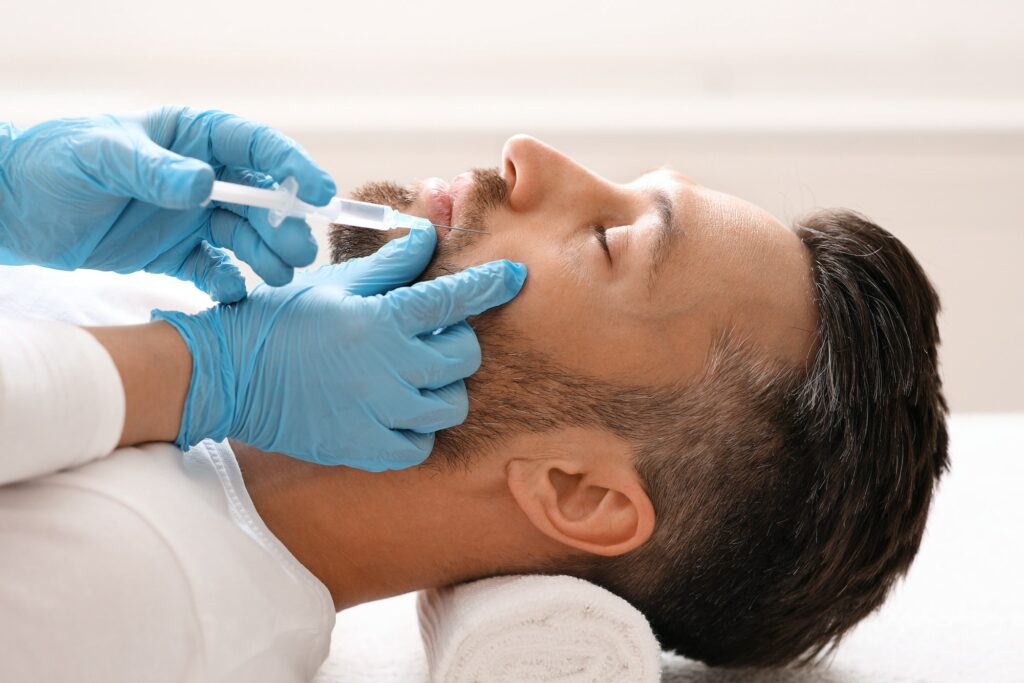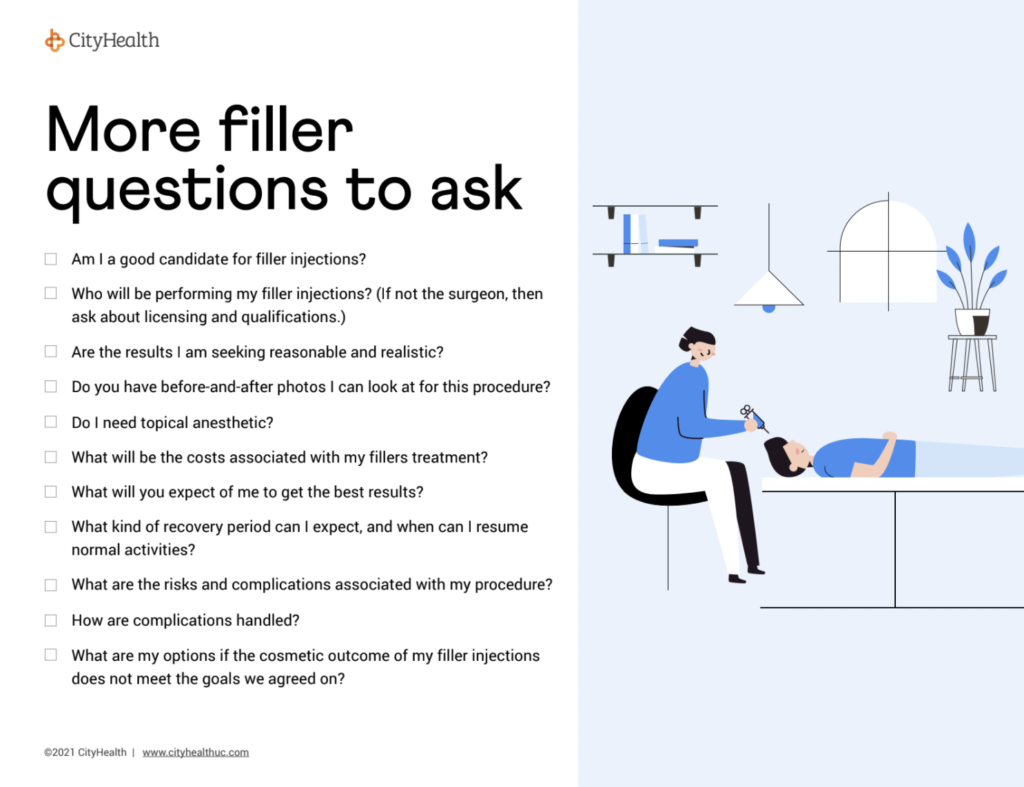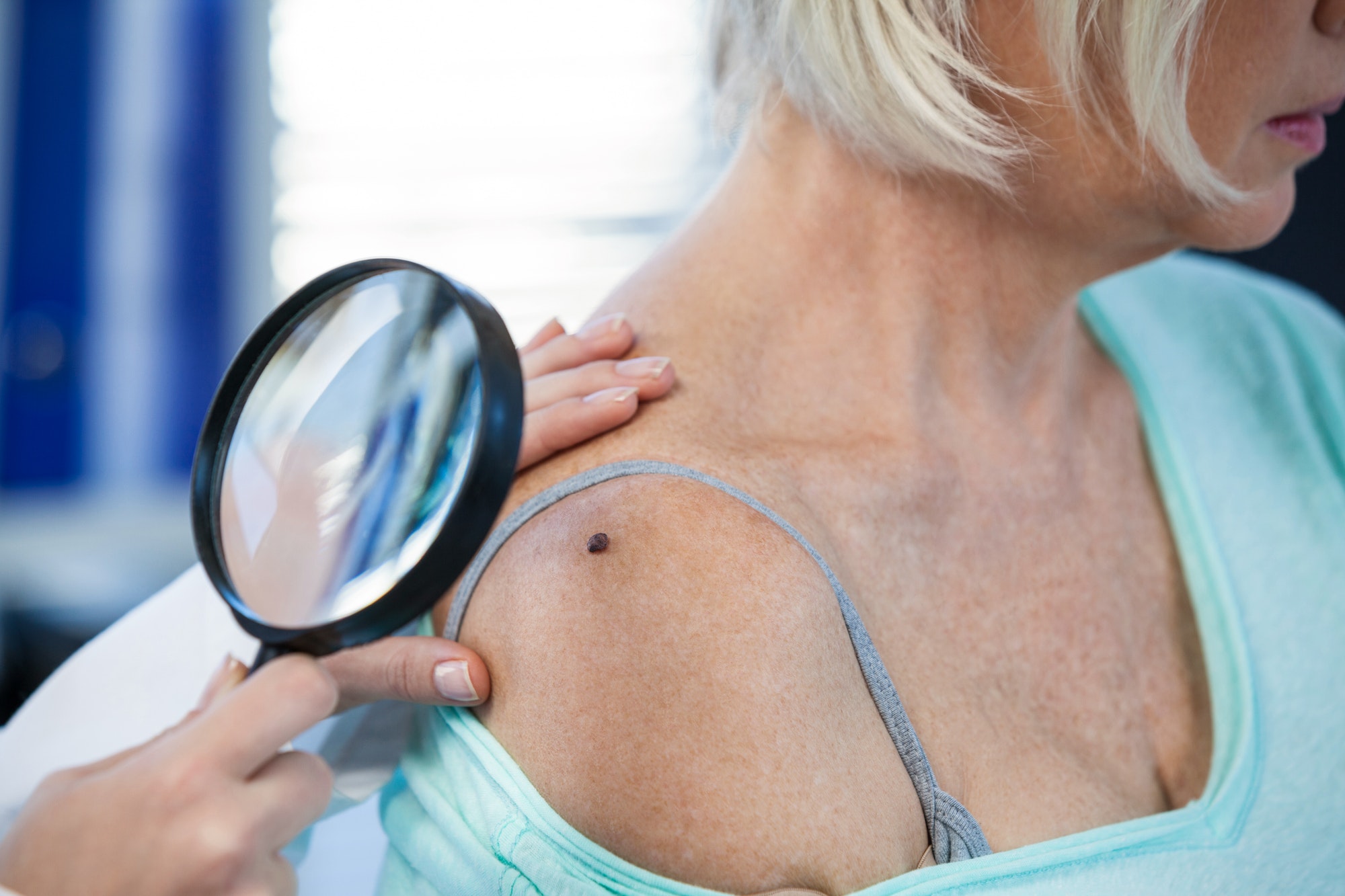Today we’ll be breaking down everything that you need to know about dermal fillers.
Whether you’re curious about the raving your friend has done about her recent fillers, the reviews you’ve seen online, or are considering booking an appointment for fillers, this article will walk you through all the key decision-making points.
There are so many treatment and procedure options for improving your skin’s appearance, but it’s important to know your options and the potential benefits and drawbacks to make sure you get the safest and best results.
We’ll start off by addressing a few common questions before delving into the details.

How do dermal fillers help reduce the appearance of aging?
Oftentimes, the appearance of facial aging traces back to volume loss. Without the thickness and volume of young skin, lines and wrinkles begin to appear in the skin’s surface.
You may notice that your face begins to look more hollow as areas slim down. More contours begin to appear in places that used to be plump.
Because we lose subcutaneous fat as we age, the muscles in our face to operate under a thinner level of skin. When this happens, it highlights the appearance of the muscles underneath the skin’s surface, which appears as more noticeable deep lines and increased fine lines.
What dermal fillers do
As the name implies, dermal fillers can “fill up” the void left by declining subcutaneous fat levels. Dermal fillers can be used to restore skin to it’s previous, more youthful appearance. Or to alter the shape of facial features on younger people who are unhappy with their appearance, such as making cheeks look plumper.
What are dermal fillers?
Fillers are gel-like substances that are injected into different areas of the body to boost volume and enhance contours. Dermal fillers are typically applied to the face as part of facial rejuvenation treatments to enhance appearance. Fillers are temporary treatments for facial aging and overall facial enhancement, but can be used on other parts of the body, such as the hands.
Fillers are not permanent, and ongoing treatments are needed to maintain long-term results. As they are minimally invasive procedures, fillers are ideal for minor fixes. They can’t address certain drastic results or lifting that would require facelifts or plastic surgery.
They can reduce the effect of wrinkles by smoothing them out, alongside a host of other cosmetic concerns. They also can potentially address an array of problems such as:
- Smoothing out marionette lines, smile lines, and parentheses
- Improving symmetry in features
- Lip plumping and enhancement (lip fillers are quite popular nowadays!)
- Softening nasolabial folds (deep smile lines)
- Filling in acne scars
- Smoker’s lines and worry lines
- Rejuvenating hands
- Smoothing wrinkles and furrows between the brows, frown lines, and crows feet
Although fillers can be a safe and effective treatment for many areas of concern, it’s important to also be realistic about the results and expectations.
While dermal fillers can bring improvements in many areas, they are not a fix-all for everything. Because fillers are minimally invasive, they likely won’t help you achieve your beauty goals in just one or two applications- it may take a few treatments to gradually build up to your desired look. Additionally, discoloration, dark circles, and puffiness can’t be treated by fillers.
Why are there so many different types of fillers?
The concept of dermal fillers is simple, but there are many different types of filler brands. These filler brands differ in their chemical makeup, longevity, physical softness, and density.
Usually, fillers are defined by the substances they are made from. Softer fillers might be ideal for softer areas of the face, whereas denser filters might be used in areas like enhancing cheekbones.
It’s good to take a scan of some different options so that you have some background information when discussing treatment details during your consultation with your dermatology specialist.
Here are some of the most commonly used substances and FDA-approved brand names.
Most popular dermal fillers
Hyaluronic Acid (HA)
Hyaluronic acid is already found in your skin. It’s a naturally occurring chemical that keeps your skin hydrated. The results from hyaluronic acid fillers are temporary and typically last from 6 to 12 months.
Hyaluronic Acid fillers are the most temporary option and are popular among first-time patients. These fillers are of a lower density and can be absorbed naturally by the body over time. Some FDA-approved and widely popular Hyaluronic Acid fillers include Juvederm and Restylane products.
Calcium Hydroxylapatite
Calcium Hydroxylapatite is a mineral found in bones. Calcium hydroxylapatite treatments are minimally invasive but last a little longer than Hylauronic Acid fillers. Expect Calcium hydroxylapatite-based fillers to last for up to 18 months.
Calcium hydroxylapatite produces very natural results and is extremely safe with a low risk of side effects. It’s a popular and effective choice for larger creases like nasolabial folds, frown lines, and marionette lines, and is also FDA-approved for use on the hands. Radiesse is a leading brand for this type of filler.
Polylactic Acid
Poly-L-lactic acid is a synthetic and biodegradable material. These fillers are unique in that they’re what’s known as a stimulator because they cause your body to produce collagen after injection. Instead of instant results like the other fillers, these results appear gradually throughout the months after the procedure. Despite this seemingly slow start-time, Polylactic Acid fillers are considered semi-permanent and results can last for up to two years or more after injection.
This is a popular filler type for the lower areas of the face like the chin, lips, and mouth areas. Generally, patients will need multiple treatments throughout the month to achieve the desired results, but the results will last longer than other fillers. Sculptra is the leading brand for this type of filler.
Polymethylmethacrylate beads (PMMA)
Polymethylmethacrylate beads can’t be absorbed by the body, so they’re the only approved filler that’s considered permanent (but remember that in the world of fillers, “permanent” means several years, not necessarily a lifetime).
These types of fillers are typically used around the mouth or on the lips, and to treat deep furrows or creases. They’re also FDA-approved to treat deep acne scarring and are particularly effective on smile lines. Bellafill is the brand name for PMMA fillers.
How long do dermal fillers last?
Depending on the brand, your results from fillers can last from 6 months for Hyaluronic acid-based products like Juvederm or Restylane, to over 5 years for permanent fillers like Bellafill.
The exact time will depend on several factors, such as the extent of aging before treatment (deep lines take more product to fill and may return quicker than shallower fine lines), follow-up schedule, and your general skin and physical health.
Your dermatology specialist will likely have some recommendations on the best treatment options to achieve your desired results.

Are dermal fillers safe?
Make sure you’re receiving FDA-approved brand fillers from a certified dermatology specialist.
This might require you to do some due diligence and fact-checking as you look for different filler clinics. You can find a clinic near you by doing a Yelp search, a Google search for local businesses, or ask a friend who’s had the procedure done and was happy with their results.
Although Groupon is popular for beauty and aesthetic services, avoid selecting a clinic based on Groupon deals because the clinics don’t have to be certified to post deals.
For highly visible cosmetic procedures like face fillers, you’ll want to play on the safe side. Some clients will even travel to larger cities like Los Angeles or New York for their procedure because of the larger selection of clinics and physicians.
You want to make sure you are working with a licensed physician, board-certified cosmetic surgeon, or licensed dermatology specialist. Once you’ve narrowed down some businesses, check their qualifications. Note that a board-certified plastic surgeon will likely charge a premium for fillers, and in many cases this extra cost is unnecessary.
Dermatology specialists typically have much more experience in minimally invasive procedures like fillers, are trained and licensed, and often charge less.
Finding a safe clinic and physician to conduct your filler procedure would be the most importantly advised safety step.
Another important safety point is to beware of silicone injections. These are unsafe fillers and are not FDA-approved. They are often offered by unlicensed individuals, so seeing silicone fillers on the service menu can raise red flags and help point out an uncertified practitioner. Silicone is not an option for facial fillers and should be avoided because it does not break down in the body. Silicone is permanent, and injected silicone can spread to other organs and result in severe health problems.
Lastly, don’t be afraid to ask questions about the treatment and brands that they use- safe and well-functioning clinics should have no hesitation in transparency and walking you through the process they use.
What is the difference between Botox and fillers?
Botox and dermal fillers are commonly confused, but they work in completely different ways.
Botox is an injectable muscle relaxer, with effects typically lasting for 3 or 4 months. It works by relaxing the muscles near naturally occurring wrinkles, such as around the eyes and mouth. Botox is typically not used for fine lines on the face. Because Botox relaxes muscles, it has applications beyond dermatology. It can be used off-label to address issues like hyperhidrosis (excessive sweating), migraines, and Temporomandibular joint disorder (TMJ), a painful jaw disorder.
Not all wrinkles are caused by muscle movement, and that’s where dermal fillers come in.
Dermal fillers are also injectable and can be used to treat wrinkles and fine lines, as well as to firm and plump up small areas of the face such as the lips or cheeks. Fillers are often used for reshaping purposes like hollowing or flattening.
Botox and fillers can treat slightly different problems in different areas of the face, and sometimes they are used together in treatment. Dermal fillers typically last longer than Botox injections but can carry more risks and side effects. However, severe side effects for both treatments are rare.
Both botox and dermal fillers require re-application to maintain long-term results and are both widely available. Your dermatology specialist will walk you through their recommendations for the results you want to achieve.
How much do fillers cost?
The cost of dermal fillers depends on the extent of treatment. In most cases, fillers are charged per vial or per needle, so the final cost depends on how many vials and how many treatments you get.
The cost also depends on the dermatology specialist’s degree of experience, the type of dermal filler used, the result you want to achieve, and the geographic location of the clinic.
Offices typically charge around $500-$1000 per vial of filler. Individual fillers, depending on the brand and treatment can average from $500- $3000. Most patients will use one or two vials per treatment area, per session.
Health insurance does not cover dermal fillers. You can learn more about national plastic surgery statistics published by the American Society of Plastic Surgeons in 2020.
What’s it like getting dermal fillers?
Dermal fillers are a popular and widely used treatment for enhancing appearance. The process is quick, the results are instant, and there is little to no downtime or recovery time needed.
Your CityHealth dermatology specialist will start your treatment with a consultation to discuss your unique concerns and goals before suggesting the appropriate treatment. We’ll also review your medical history and inquire about any allergies, skin conditions, and medications. We’ll also consider any past treatments you’ve had with fillers, lasers, minimally invasive facial procedures, or any other facial surgeries.
We will discuss the course of the treatment, the type of filler recommended, how long you can expect the results to last, and an estimate of the final cost.
We’ve prepared a checklist of questions to ask your clinician before your visit. Save or print this and bring with you to your consultation.

Dermal filler in-office procedure
Here’s what you can expect the day you go in to get your fillers.
The first step will be facial mapping. Points on your face may be marked for injection, and photographs may be taken at this point for comparison later. The clinician will consult with you and explain the treatment again before beginning the injections.
The next step is cleansing. The areas on your face marked for the injection will be cleaned with an antibacterial agent. An anesthetic ointment might be applied, or a cold instrument will be applied to chill the surrounding skin.
Finally, it’s time for the injections themselves. This is actually very quick. The filler is injected via a very fine sterile needle or a blunt-tip cannula. The whole process might take from 15 minutes to an hour.
The dermatology specialist will inject, massage, evaluate, and apply additional fillers as needed. Once the results are completed, markings will be cleaned off. You can apply ice to reduce swelling and discomfort.
What is the dermal filler recovery process like?
Even permanent dermal fillers are minimally invasive and require minimal aftercare. Treatments are done in-office, and you can go home immediately afterward.
The most common side effects are mild swelling around the injection site, common with all injections.
Here are a few tips to minimize any discomfort associated with the procedure:
- Hydrate by drinking plenty of water before and after the treatment. This will help keep your skin (and the rest of you!) healthy.
- Avoid salt for a few days before and after your treatment. Salt can cause water retention and swelling.
- Avoid alcohol or blood thinners (including Aspirin and Advil) before the procedure. Blood thinners can increase the likelihood of bleeding.
- After the procedure, you may want to take an antihistamine and do a light cardio workout to help reduce swelling.
What if I don’t like the result? Can fillers be removed?
We all know the terror of post-haircut regret, and it can definitely be anxiety-inducing to imagine being stuck with a filler treatment that you don’t like on your face. But rest assured, there are ways to undo or adjust the results. Fillers can be dissolved with hyaluronidases enzymes, in case too much filler was injected or you’re unhappy with the results.
Are dermal fillers right for me?
Dermal fillers can be a safe and minimally invasive way to improve your overall appearance, confidence, and satisfaction. The results are often very natural and can be maintained with the right care and follow-up. Hopefully, you feel confident in evaluating your options after reading this article.
With a good idea of what to expect before, during, and after the treatment, you’ll be able to look at different filler treatments through the lens of safety and effectiveness. If you have any questions about cosmetic fillers, book a consultation today!




